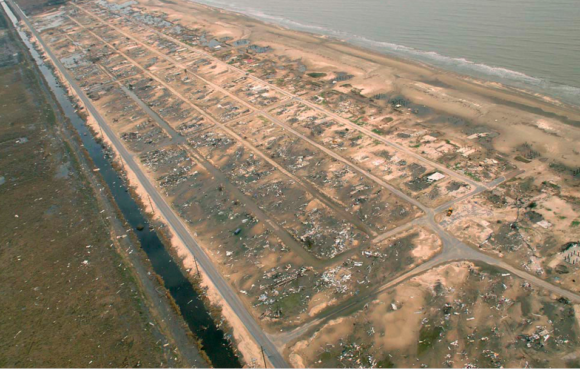Five major oil refineries that produce 10 percent of the U.S. supply lie within a zone where catastrophic damage is expected from Hurricane Laura, according to a blog posted by Enki Research on Wednesday afternoon.
The hurricane was forecast to come ashore in Louisiana just east of the Texas state line this morning with winds near 145 mph. While the area is sparsely populated compared to Houston just to the west, the region is a major energy producer.
“All told, the Valero, Motiva (the largest refinery in the US at over 600,000 bbl per day), ExxonMobil/Beaumont, Total, and ConocoPhillips refineries are responsible for over 10 percent of US refinery capacity,” disaster modeler Chuck Watson wrote on Enki’s blog.
Watson projected $20 billion to $25 million in damages from the storm on Wednesday morning, but in a post later in the day said the number may reach $30 billion, “depending on what happens at the refineries, which are multi-billion dollar complexes.”
Watson said the 15- to 20-foot storm surge pushed by the hurricane will swamp refineries that line the shore of Sabine Lake. In an earlier blog post, he said those refineries might not come back on line for a year — and may shut down permanently depending on the political climate.
“Let’s say the Motiva facility is a near total loss. If you are a decision maker in a company looking at investing perhaps as much as three to five Billion dollars and take several years to rebuild, are you going to do that in the absence of iron-clad reassurances the government isn’t going to shut you down before you’ve broken even?”

The National Hurricane Center said Laura had maximum sustained winds of 145 mph at 4 p.m. (CDT) on Wednesday afternoon. Wind shear near the coast may weaken the storm slightly before it makes landfall, but still Laura will bring an “unsurvivable storm surge with large and destructive waves” from Sea rim State Park in Texas to Intracoastal City Louisiana, the center’s forecast said. The surge could penetrate 40 miles inland and will not recede for several days, the center said.
The U.S. Geological Service said Laura’s storm surge is expected to inundate 61 percent of Louisiana’s sandy beaches. The storm will wash away sand dunes, making the region more vulnerable to future storms, the USGS said.
Meteorologist Jeff Masters of Yale University said in a post on Yale University’s Climate Connections blog that damage from Laura may be more destructive than Hurricane Rita, which struck the same region in 2005. Rita’s maximum winds were 115 mph and the storm drove a storm surge of 15 to 20 feet to the Bolivar Peninsula in Texas, near the Louisiana state line.
“The storm surge destroyed 90 percent of the homes in Cameron, and destroyed all of the structures in Holly Beach (population 300), with the only human-made features remaining after the storm being power poles, concrete slabs, and roads,” Masters wrote.
StreetView photographs on Google Maps shows that many structures in Holly Beach have since been rebuilt on stilts towering high about the ground.
Rita also inundated downtown Lake Charles, 30 miles inland, with water reaching a depth of up to six feet.
CoreLogic said late Wednesday that 1.1 million homes, with $265 billion in reconstruction cost value, could be affected.
“The right front quadrant of a hurricane presents the greatest threat of storm surge,” CoreLogic said. “Based on the current track, true Category 4 storm surge heights would likely affect Lake Charles and Jennings with a slightly lesser degree of intensity for Beaumont and Lafayette.”
Was this article valuable?
Here are more articles you may enjoy.

 Uber Sued by FTC Over ‘Deceptive’ Subscription Sign-Ups
Uber Sued by FTC Over ‘Deceptive’ Subscription Sign-Ups  US Regulator Takes Initial Steps to Boost Self-Driving Cars
US Regulator Takes Initial Steps to Boost Self-Driving Cars  As Trump Considers Auto Tariffs Pause, Parts Exemptions Could Be Key for US Industry
As Trump Considers Auto Tariffs Pause, Parts Exemptions Could Be Key for US Industry  Uber Spends Six Figures on Ads in Latest NY Insurance Reform Push
Uber Spends Six Figures on Ads in Latest NY Insurance Reform Push 